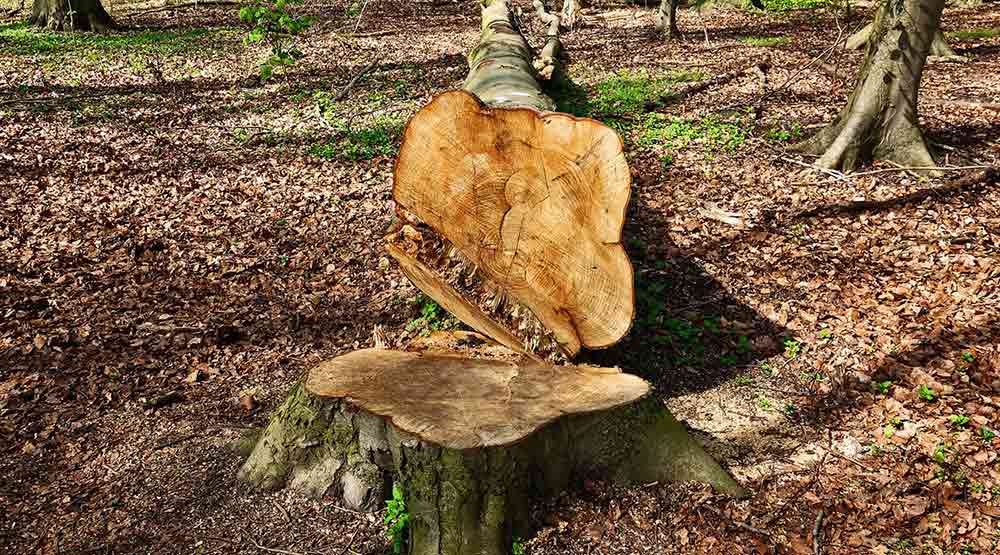A myth to dispel, an important aspect to highlight: when certification becomes a criterion for responsible choice.
Let’s be honest, often when we hear about constructions or works in wood, we feel somehow responsible and guilty for the ferocious uncontrolled deforestation of our planet that the teacher at school or our parents told us about as children. An even instant sense of guilt assails us at the thought of the time immemorial that man has spent stocking up on such an important raw material, causing ecological disasters whose effects we fear and which we have often heard about.
And for this reason, very probably, when faced with the choice of hypothetical fixtures or doors, we are led to prefer industrial materials such as PVC, apparently free of faults and cheaper, compared to actual wood, a victim of human greed and obviously more costly. But are we sure that we are not believing in a real urban legend?
The truth is that we are actually wrong. And not by little.

In the last 20 years, in fact, consumers, and more generally public opinion, have shown a profound interest in the possibility of tracing the origin of the wood used for the creation of the final product and a consequent predilection towards that material coming from forests managed in a sustainable way, both from an ecological, economic and social point of view. Hence the birth of international non-governmental organizations, such as the non-profit Forest Stewardship Council (FSC – in Italian “Forest Management Committee”). In 1990, in California, a team of producers and consortia active in the sector agreed on the need to establish a criterion for the sustainable management of forests. Three years later, the FSC was born and was the first to define a voluntary and independent certification system, specific for the forestry sector and wood products, operating at an international level.
The aim, therefore, is to protect forests by ensuring that they are exploited in a sustainable manner by imposing a series of strict criteria to be respected. For the FSC, forest management must not only be environmentally friendly but also:
- Socially useful: wood harvesting must represent a social, working and economic advantage for local populations.
- Economically sustainable: the profit obtained must not harm or come at the expense of the forest resource nor the populations involved.

For these reasons, the FSC NGO is governed by a sovereign decision-making body divided into 3 chambers: one represents environmental interests, one social interests, one economic interests, in which the voting power is equally distributed and takes into account the balance of interests. of the countries of the South of the world compared to those of the North.
Concretely, this Organization has managed to identify 10 Principles & 56 Criteria (P&C) that must absolutely be respected to certify the sustainable management of a forest or forest plantation. Of course, they must be adapted to local conditions, taking into account the many differences that may exist between various forestry units around the world.
The FSC® certified brand refers to all products of forestry origin such as wood (round wood, marked, veneered wood, firewood, wood chips, etc.) and wood-based products (panels, furniture, frames, pellets, etc. ), but also wood derivatives such as cellulose pulp and paper. Non-wood forest products such as mushrooms, honey, berries, gum, resins, cork, etc. can also be FSC® certified. provided they obviously come from correctly managed and consequently certified forests.

FSC Italia, based in Padua, was founded in 2001 and was officially recognized by FSC as a national initiative in 2002. It operates in accordance with the objectives and mission of FSC International to stimulate the spread of certification in our country too. (In-depth analysis: “The principles and criteria of the Forest Stewardship Council (FSC) for responsible forest management”, Forest Stewardship Council – FSC-Italy Group).
To support this mission which has become very important, there is also the PEFC, Program for Endorsement of Forest Certification schemes, developed in 1998 by European forest owners and the wood industry to facilitate the mutual recognition of existing forestry certification schemes.
The PEFC proposes criteria and indicators that start from the difficulties that have emerged in identifying a suitable tool to respond satisfactorily to the peculiar situations of the European context and from the need of private owners to have a flexible tool that responds to the need to implement ecological management appropriate, but also aimed at achieving social benefits and economically valid. It therefore presents itself as an effective alternative to existing certification systems, first of all the FSC, considered inadequate especially in the case of small forestry properties.

In 1993, during the Ministerial Conference for the Protection of Forests in Europe, the current definition of sustainable forest management was adopted: “the management and use of forests and forest land in the forms and at a rate of use that allow them to be maintained biodiversity, productivity, capacity for renewal, vitality and the potential to fulfill, now and in the future, relevant ecological, economic and social functions at local, national and global levels, without causing damage to other ecosystems.”
Therefore, for twenty years now, the use of the forest has evolved towards sustainability criteria, requiring increasingly punctual and complete certification. To further dispel the myth of ferocious deforestation in the presence of wood products, it is also useful to underline the FAO investigations which demonstrate that in Europe the forest mass is constantly growing and highlight that in tropical countries the loss of forest, although greatly reduced in recent years, is 80% due to agricultural extension and natural phenomena.
Data from the IPSOS Observatory have also highlighted that, when it comes to purchases, many consumers declare their willingness to spend up to 20% more on eco-conscious products.
Therefore, wood remains the raw material par excellence, thanks to its very limited pollution during processing, and to the fact that it can be produced, restored, disposed of and reused in perfect symbiosis with the surrounding environment. We can therefore go back to sleeping peacefully, even with wooden windows or frames.
…Did you know that?
From the perspective of sustainable forest management, the relationship between adult plants, which are cut, and young ones, which are planted, is kept constant, thus guaranteeing environmental balance. Furthermore, it should be underlined that young plants, compared to more mature ones, allow a greater supply of oxygen by retaining CO2.

